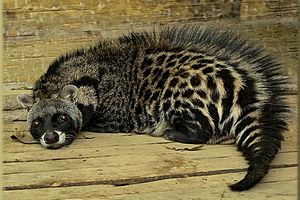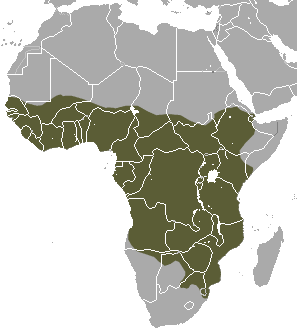African civet facts for kids
Quick facts for kids African civet |
|
|---|---|
 |
|
| Conservation status | |
| Scientific classification | |
| Genus: |
Civettictis
|
| Species: |
civetta
|
| Subspecies | |
|
C. c. civetta (Schreber, 1776) |
|
 |
|
| Range of the African civet | |
| Synonyms | |
|
List
Viverra civetta Schreber, 1776
V. poortmanni Pucheran, 1855 |
|
The African civet (Civettictis civetta) is a fascinating mammal. It is a large type of civet that belongs to the Viverridae family. These animals live in Sub-Saharan Africa.
The African civet is currently listed as a Least Concern species. This means it is not in immediate danger of extinction. However, in some areas, they face threats from human activities. Sometimes, African civets are kept by people to produce a special scent called civetone. This scent is used to make certain types of perfume.
Contents
What is an African Civet?
The African civet is the only member of its genus, Civettictis. It looks a bit like a cat mixed with a raccoon or a dog. They have a unique appearance with black and white markings. These markings help them blend into their surroundings at night. They also have a crest of hair that runs along their back. This hair can stand up when the civet feels threatened.
Physical Features
African civets are medium-sized animals. They can weigh between 7 and 20 kilograms (15 to 44 pounds). Their body length can be from 67 to 89 centimeters (26 to 35 inches). They have a long, bushy tail that is about half their body length. Their legs are relatively short, and they have five toes on each foot. Their claws are not retractable, meaning they cannot pull them in like cats do.
Their fur is coarse and has a striking pattern. It usually has black spots and stripes on a grey or cream background. They have a black mask-like pattern around their eyes. This makes them look a bit like a bandit!
Where Do African Civets Live?
African civets are found across a large part of Africa. Their habitat stretches from Senegal in the west to Somalia in the east. They also live southwards to Namibia and South Africa. They prefer areas with dense vegetation and tall grasses. These places offer good cover for hunting and resting. They are often found near water sources like rivers and swamps.
Their Home Environment
These animals are very adaptable. They can live in many different environments. This includes forests, woodlands, and savannas. They avoid very dry areas like deserts. They are also found in some agricultural areas. This is especially true if there is enough cover and food.
What Do African Civets Eat?
African civets are omnivores. This means they eat both plants and animals. They have a very varied diet. This helps them survive in different environments. They are known for being opportunistic feeders. They will eat whatever food is available.
Their Diet
Their diet includes a wide range of items:
- Small animals: They hunt rodents, insects, birds, and reptiles.
- Fruits and plants: They eat many types of fruits, berries, and seeds.
- Carrion: They will also eat dead animals they find.
- Eggs: They often raid bird nests for eggs.
- Invertebrates: Snails, crabs, and even scorpions are part of their diet.
They have a strong sense of smell. This helps them find food, especially at night.
How Do African Civets Behave?
African civets are mostly solitary animals. This means they prefer to live alone. They are also nocturnal. This means they are most active during the night. They spend their days resting in dense vegetation or burrows.
Nighttime Activities
At night, they come out to hunt and forage for food. They are very good at moving quietly through the undergrowth. They use their excellent senses of smell and hearing to find prey. They are not very fast runners, but they are agile.
Communication
Civets communicate using various sounds. They can growl, cough, and even "hiss" when threatened. They also use scent marking. They have special glands that produce a strong-smelling liquid. This liquid is called civetone. They use it to mark their territory. This tells other civets that the area is occupied.
Why Are African Civets Important?
African civets play an important role in their ecosystems. As omnivores, they help control populations of insects and rodents. They also help spread seeds by eating fruits. This helps plants grow in new areas.
Conservation Status
As mentioned, the African civet is a "Least Concern" species. However, local populations can be affected by habitat loss. This happens when their natural homes are destroyed for farming or building. They are also sometimes hunted for their meat or for their civetone. Protecting their habitats is important for their future.
Images for kids
See also
 In Spanish: Civeta africana para niños
In Spanish: Civeta africana para niños




